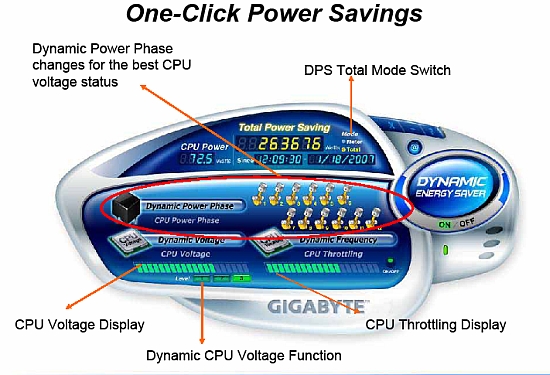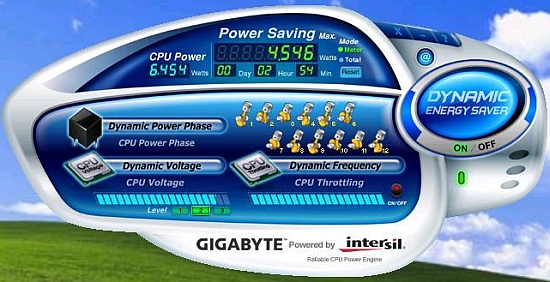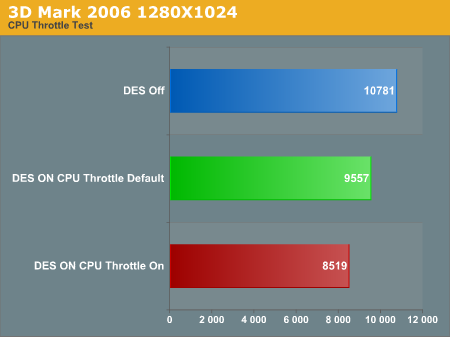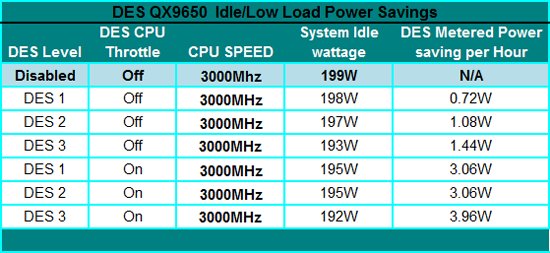
Original Link: https://www.anandtech.com/show/2425
Gigabyte goes "Green" with DES software
by Rajinder Gill on January 23, 2008 10:00 AM EST- Posted in
- Motherboards
Our initial reaction to Gigabyte's DES (Dynamic Energy Saver) software was stated in the GA-X48T-DQ6 review a few weeks ago. Although we had toyed with this new software from Gigabyte, time constraints led us to skimming the surface of its full potential during our testing. DES software will be available on all Gigabyte motherboards that are Intel 45nm processor compatible. Currently there are plans for six models - from the budget range P35 boards, right up to the flagship GA-X48T-DQ6 motherboard that we are using as our platform for testing today.
As Gigabyte is putting quite a bit of energy (excuse the pun) into the launch of DES, we decided that a small breakout article about this technology would be interesting. We wanted to see if DES brings anything exciting enough in the way of power savings to get Al Gore's green seal of approval for AnandTech's test lab. However, if Al does arrive, we are sure he will be less than pleased with our gaggle of quad-core processors, 8800 Ultra cards, and extreme benchmarking equipment. To be more precise, the cascade coolers we utilize send our watt-meter off the scale during initial switch-on surge. Stable power draw is in the region of 2200W when both units have reached cooling capacity. In case anyone is wondering just how much power it takes to send a watt-meter off the scale, it's around 3588W (UK 220V -13 amp sustained maximum).
Needless to say, we are "green enough" not to subject our wallets or the planet to this kind of power abuse on a regular basis. Perhaps DES will help remove some of our guilt. We hope that it will. However, once we switch on those big power-guzzling cascades, using DES would be like eating a hearty 1500 calorie "everything is fried" breakfast and then topping it off with a sprinkle of bran flakes to claim that we are monitoring our long-term health. Actually, scrap that statement - every little bit helps right?
Owning a power consumption meter can be a remarkably enlightening experience; you either find out you are drawing way more power than you thought you were, or that you are drawing a lot less power than you had been lead to believe. Either way, we are constantly being reminded by those around us that we should do our utmost not to waste electricity.

Before we begin testing the merit of DES's purported 1-touch power saving capabilities, we must point out that the features used by DES are all made possible by Intel's VRM 11.1 specification, which has been designed specifically for Intel's Hafnium based 45nm processor technology. Firstly, VRM 11.1 allows the PWM controller to receive a signal from the processor to shut down PWM phases during low load or idle processor states. Secondly, the PWM is able to receive a signal from the processor to modulate core frequency that creates a throttling type effect, further reducing power consumption during light processor loading situations. Both of these functions require an operating system driver to operate - basically the software tells the CPU when to send the phase switching/VID control/modulation signal to the PWM controller, which in turn sends a signal back to the processor to throttle down or up.
Over the past week, we ran a series of load and idle tests monitoring for power draw and potential savings, both using DES and by manual manipulation of voltage settings via Gigabyte's Easy Tune 5 software. We aim to find out just how much power one click of the DES user interface button allows and if we can match these savings by manual manipulation of the processor's voltage settings in the BIOS. Let's take a look at how much power DES allows us to save on a high end X48 board.
Test Setup
| Gigabyte GA-X48T-DQ6 Testbed | |
| Processors | Intel Core 2 Extreme QX9650 Quad-core, 3GHz, 2x6MB Cache, 1333FSB Intel Core 2 Extreme QX6800 Quad-core, 2.93GHz, 2x4MB Cache, 1066FSB |
| CPU Voltage | Various according to DES Level |
| Cooling | Water cooling: Swiftech Apogee GTX, PA120.3 Rad, 3 X Laing DDC Ultra Petra Top pumps in series, 3x Panaflo 120mm Fans 7-10V |
| Power Supply | OCZ 1000W |
| Memory | OCZ DDR3 PC3-14400 (DDR-1800) Platinum
Edition 2GB XP, 4GB Vista 64 |
| Memory Settings | Default via SPD |
| Video Cards | Asus 8800 GTS 640MB |
| Video Drivers | Nvidia 169.09 (XP) |
| Hard Drive | Western Digital 7200RPM 250GB SATA 3/Gbps 16MB Buffer |
| Optical Drives | Plextor PX-B900A |
| Case | Lian Li -75 |
| BIOS | F4B |
| Operating System | Windows XP 32 Bit SP2 |
| Watt Meter | Paget 9149 |
| . | |
We decided to use Windows XP 32-bit as our test operating system with 2GB of memory installed. The Stanford Folding@Home client was used to simulate 100% loading tests and to test for stability at a variety of processor core voltage levels. Prime95 Torture tests were also run in small FFT mode to place a maximum load on the CPU in order to determine the worst case scenario for voltage droop at each of the available DES levels. As we are monitoring for outright system power consumption and savings, we did not account for PSU losses in any of the idle and full load wattage figures. However, PSU load efficiency will obviously affect the total level of power saving that can be realized. The most important factor to us today is how much overall power we can save at the wall. We did find that the watt-meter cycled between a variety of voltages at both idle and full load of the processor. For this reason, the figures shown in our tables represent averages that are accurate to around +/- ~.5W.
Using DES - How to?
 |
Explanation of features
The GA-X48T-DQ6 we are using for our testing today uses the Intersil ISL6327 PWM controller. Intersil has made the power saving features of their VRM 11.1 specification controllers versatile enough to allow multi-step phase and voltage control on-the-fly. This in turn has allowed Gigabyte to produce a software based user control panel for the controller, so that users can turn some of these features on or off as required. Let's take a look at the key features of the D.E.S. GUI.
Dynamic Voltage: This is a three step Vcore reduction feature. Each stage will subtract a level of Vcore from the stock processor VCore value. In the case of our QX9650 stock voltage is 1.223V. Stage 1 reduces Vcore by 0.052V, Stage 2 by 0.062v and stage 3 by 0.085V. These values are subtracted from the stock Vcore value, and are not user controllable.
Dynamic Power
Phase: This
function becomes active when the Dynamic Voltage function is set between 1 and 3.
The Intersil 6327 controller allows for either 2,3,4,5 or 6 phase operation. Gigabyte
refers to this phase switching capability as "5 gear" control. The number
of active phases is shown as cycling cylinders in the GUI interface of DES. The
number of active phases when DES is enabled is automatically varied according to
the load placed upon the CPU. In the case of Gigabyte's flagship GA-X48T-DQ6 motherboard,
the number of active cylinders shown in the DES GUI must be divided by two to reveal
the actual number of active phases. Remember, the GA-X48T-DQ6 uses a 6-phase PWM
supply and not a 12-phase supply as commonly thought. Gigabyte uses parallel inductors
in this design, meaning there are twice as many PWM inductors (the small square
devices with R80 printed on them near the CPU socket). For many users, this wrongly
creates the illusion that this is a 12-phase power supply.Gigabyte has probably used 2 off the shelf components, rather than sourcing a more expensive large single component of equivalent value.
Low load conditions using a QX9650 results in the CPU power supply switching to 2-phase mode. Meanwhile, 100% processor loading results in 4-6 phase operation depending upon current draw and PWM MOSFET temperatures.
CPU Throttling: This function sets the level of performance throttling. Selecting "On" enables a higher level of throttling based upon CPU loading than when this function is set to "Off". The effects of this function can be seen in the 3D mark 06 scores results below;

It is clear that the "throttling" function has an impact on system performance at a given processor speed. For web browsing or word processing applications, the use of the CPU throttling function is unlikely to bring a noticeable degradation to perceived performance. For gaming, setting the CPU throttle function to "Off" is obviously the best bet to maximize frame rates.
A Few Pre-Requisites for Full Use of DES
Intel's own power saving features known as C1E and EIST must be set to disabled before DES gains full control of altering processor core voltage on-the-fly. It is also important to point out that full operational use of DES is limited to stock (Auto) BIOS settings for both processor and memory busses.
A back door to overclocking is available via Gigabyte's CIA2 dynamic overclocking setting. However, full use of the available CIA modes is limited by the preset VCore levels that DES employs (see the DES power draw tables for the static VCore values used by DES). For example, the maximum CIA2 level of "Full -Thrust" overclocks our QX9650 to 3.725GHz under load, which is too high for stability even with a DES level of 1 selected.
Test Results
 |
We used four instances of Folding@Home to load each CPU core individually. The DES power savings column shows that savings of 7W per hour is possible if the CPU is loaded 100%. Around 20,000 users worldwide currently participate in the Stanford Folding@Home program, which is used to help protein related disease research. Many of the participants run quad-core processors at a 100% load, almost 365 days a year. Based upon current 1kWH unit pricing in the US, a DES setting of 3 would equate to an approximate $6.63 dollar saving over the course of one year - if the processor retains a 100% load throughout this time.
Okay, these numbers are not exactly substantial, but they are better than no savings at all. To an individual, the power savings shown here may seem miniscule. The broader picture is that the DES software will be available on most of Gigabyte recent boards. It's just a matter of how many people decide to put the software to use. As with most forms of power economy, it takes a global effort to instigate meaningful power consumption reductions. A further look into why the power savings are minimal with our setup is that Intel's QX9650 - and their 45nm processors in general - are very power economical by design, especially at stock settings. Again, the Hafnium based 45nm technology shows the virtues of incredibly low power leakage at stock speeds. That is why the difference in wall power draw is so small, even when reducing Vcore at stock speeds.
 |
For word processing or web browsing, there is absolutely no harm in using DES level 3 with CPU throttling enabled. An approximate saving of almost 4W per hour is possible; again, this is not massive but every bit of savings is still worthwhile in the grand scheme of things.
 |
In this test we decided to manipulate Vcore levels manually to DES levels without using DES. We also took this a step further (the bottom row in the table) and reduced Vcore to the lowest level that we could run our QX9650 at 3GHz stable. The 45nm process allows these processors to run incredibly low levels of Vcore at 3GHz. What has become clear at this point is that switching off some of the phases does not really benefit the user by reducing system power consumption from the wall. Further, as there is no user VCore control in DES, manual Vcore tuning to lower values than DES level 3 brings the prospect of increased overall power savings.
It is important to note that Gigabyte's Easy tune 5 software allows manual Vcore adjustment within the OS. Okay, so it's not quite as easy as the 1-click feature of DES, but Easy Tune 5 is almost as easy to use for manual Vcore adjustment (two clicks to be precise). The only rub here is that it does take a little bit of time running stability software to work out just how low you can take the Vcore whilst retaining system stability. Of course, the QX9650 is currently the best processor that money can buy and represents top speed binned silicon. The lower binned processors should still allow users to undervolt the Vcore quite effectively, obviously at the cost of a lower overall CPU speed.
CIA2 Overclocking
 |
Both Easy Tune 5 and the BIOS have an automatic overclocking function known as CIA2. There are five available levels to CIA2. Each of these settings offers a percentage overclock that is dynamically engaged according to CPU load levels. As DES uses preset levels of Vcore at each stage, the only overclock CIA setting that works with all three levels of DES on our QX9650 is "Cruise". Although this only amounts to a 244MHz overclock that most performance oriented overclockers would eschew as "tiny" on a QX9650, it's better than nothing if you don't like fooling around with lots of BIOS settings. It is also worth noting that default voltage settings are used by the CIA function on all areas of the motherboard.
The user can override some of these settings by selecting manual values in the BIOS; however, Vcore control still reverts to the static presets when enabling DES. It is a little unfortunate that the DES GUI does not feature user selectable Vcore levels to allow a little more flexibility when using CIA2. The results do indicate that power saving and power usage levels are not drastically altered over stock figures. Still, a 244MHz overclock is free for the taking without a power consumption hit.
Does DES work with 65nm CPU's?
 |
We decided to run a quick test to see how well a 65nm G0 stepping CPU would hold up to the Vcore reduction that DES employs to save power. At a setting of 2.66GHz, a DES level 3 under-volt of 0.082V does not affect processor stability at all. Obviously, the power consumption figures of 65nm processors cannot compete with the Intel's lower consumption/lower leakage 45nm process Hafnium technology. Still, it is good to know that users who own 65nm G0 stepping CPU's can expect some form of compatibility and power savings with Gigabyte's DES software.
Final thoughts
D.E.S. presents the average user with an easy method of small-scale power saving. The largest group of consumers is not those who are interested in overclocking or spending hours fiddling with BIOS settings. With this in mind, Gigabyte has taken a few steps in ensuring the DES software is installed on user systems during the initial OS setup. For example, the driver/software CD auto-installs all required system drivers including D.E.S. Most users will use the auto-install function on the driver CD, meaning the software will find its home in the Windows task bar. Once installed, the software auto-alerts the user if D.E.S. has not been set up or switched on.
There is still one hurdle though:
all current BIOS releases for the GA-X48T-DQ6 enable C1E and EIST by default, and
these have to be switched off manually for DES savings to be fully realized. Gigabyte
will need to consider this and release future BIOS revisions without these functions
enabled if DES is to be successfully used by the masses. Gigabyte would also do
well to add an advanced tab to the DES GUI that allows altering the level of Vcore.
With the 45nm process proving so responsive to reduced voltage levels, we are sure
users can tune their processors for even lower levels of power consumption than
DES level 3 currently offers - provided the users take the time to do the proper
amount of testing; if not then DES is close enough in our opinion. Gigabyte are still refining the DES software and tell us that full C1E and EIST compatibility is possible. The CPU throttle function will also be improved in future releases, so that performance under load is not drastically altered.
Okay, the power savings per user are not huge, but we have to take the prospect of thousands of users enabling DES simultaneously into account. Even if many people decide not to use the software, we have no hesitation in giving Gigabyte the thumbs up for attempting to make consumers more aware of power consumption and offering an initial solution to reduce it without much user intervention.







